Are you fed up with the constant sneezing due to dust in your home? Do you find yourself cleaning over and over again, only to still find a layer of dust on all surfaces? If so, then it’s time to learn how to remove all dust from your home.
Dust is one of those home cleaning nightmares that always seems to be lingering in the air, no matter how often you clean. It can settle on window sills and furniture and accumulate in hard-to-reach places like the top of your curtains, where it’s difficult to brush away without causing more mess. For those who suffer from asthma, dust can be particularly bothersome.
Fortunately, simple tools and techniques are effective ways to rid your home of dust. From vacuuming upholstery with a specialized device to working with a resistant surface cleaner for built-up areas, removing all the dust in your home can ensure a clean environment free of allergens and irritants.
In this article, we’ll look at some tips for removing all the dirt and grime once and for all. So if you’re ready to tackle the issue, read on!
10 Tips To Remove All Dust From Home
You can take a few different tactics to remove all the dust in your home thoroughly.
① Remove Floor Clutter

Removing floor clutter to reduce dust in your home is one of the most effective ways to do so. It may seem counterintuitive at first; you might assume that removing larger items would make your home dustier, not less.
But what you should be asking yourself is this: What’s causing the dust to build up in the first place? That answer is usually stagnant air and debris that can’t make its way out of your space because of all the mess on the floor.
By clearing out that clutter and creating an atmosphere with free-flowing airflow, you’ll find that the amount of dust in your home quickly diminishes over time. Plus, having a decluttered space just feels good! It’s calming and helps improve productivity by allowing our minds to focus on things we need without constantly seeing chore reminders.
② Change Your Bedding Weekly
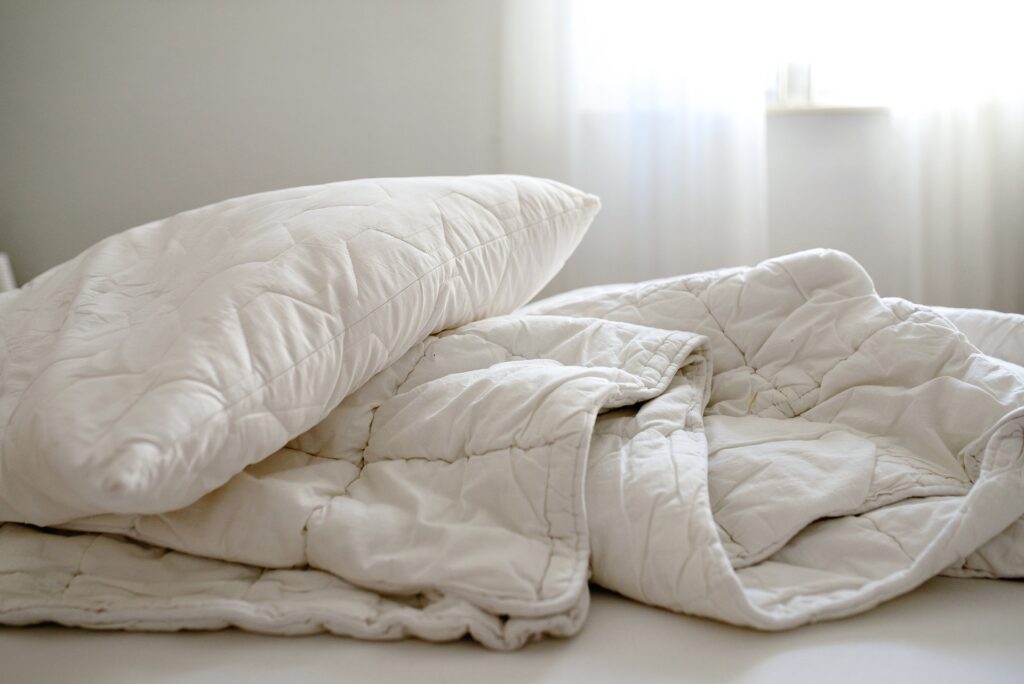
Dust mites, which are tiny animals that consume skin cells and other organic material, love bed linens and mattresses. They leave behind particles that trigger allergies and asthma as they grow over time. This can be avoided by routinely changing bed linens, including sheets, duvets, pillowcases, and mattress covers.
Imagine how many millions of microscopic skin cells you shed onto your mattress each time you go to sleep. And when it all builds up over time, dust mites have the perfect environment! Thus, frequently changing the bedding and washing them in hot water (preferably over 50°C) are the greatest ways to reduce their population. You’ll avoid breathing in those unsavory dust particles, which can cause asthma and allergy problems.
Moreover, when cleaning laundry, use solutions made expressly to get rid of allergies, like detergents with enzymes or special dust mite-targeting ingredients. By doing this, you may dramatically minimize the amount of indoor dust in your house.
③ Keep Your Closets Tidy

Go through your closet and decide what items you no longer need or want. Consider donating items still in good condition – this will help keep clutter at bay while also doing some good! Once all of the excess items are removed, vacuum, sweep, or mop the closet’s interior to remove any dust buildup. Furniture polish can also work very well when dealing with wooden surface areas such as shelves.
Airing out your closets every once in a while can also help reduce dust buildup. Open up those doors and let some fresh air circulate throughout the space for 10-15 minutes every few weeks. You should also check for any signs of mold or mildew that may have formed due to poor ventilation or dampness. This could happen during cold winter months when more heat is needed in the house, so pay extra attention if this might be an issue for you.
The last step is to organize everything left in your closet so you know where everything should go – proper organization helps keep dust from settling down on things that shouldn’t have dust on them!
Investing in drawer organizers or stacking plastic drawers might be worthwhile if you need more storage space. Having hooks installed is also ideal since they take up much less room than hangers while keeping things off the ground where dirt and dust can travel more easily.
④ Use a Doormat

The doormat is an extra layer of protection; it helps trap dirt and debris on shoes before entering your home. This means less dust being tracked inside, which makes it easier to maintain a clean environment. Additionally, the fibers of the doormat also help capture smaller particles that would otherwise be missed if you were just sweeping up or vacuuming.
When shopping for a doormat, look for one made of natural materials such as coconut husk or jute fibers. These are absorbent and tend to last longer than other synthetic materials. It’s also important to choose one with enough traction so that people don’t slip when walking over it, which can lead to even more dirt being tracked inside!
When using your doormat, vacuum it regularly so that all the accumulated dirt and dust are picked up and removed from your home. If you want your doormat to look fresh and inviting, consider rinsing or washing it occasionally, depending on its material – check the manufacturer’s instructions first!
⑤ Clean Up After Your Pet

Pets, especially dogs and cats, shed fur constantly as they groom and lounge around the house. This microscopic fur floats around until it eventually lands on furniture, carpets, and other surfaces. You’ll want to incorporate pet grooming into your weekly (or even daily) cleaning regime to combat this regular build-up of pet dander and fur.
Regular brushing sessions with a normal brush or specialized shedding tool will help reduce the amount of fur released into the air by removing some of their heavy coats before it gets to that point.
In addition to brushing your pet’s coat outside, regular baths will help ensure that any dirt or particles from outdoors don’t end up inside your home and reduce their overall amount of shedding. Regular bathing also has many other benefits, such as keeping odors at bay and providing them with much-needed relaxation time!
Lastly, when it comes time for changing bedding or other surfaces where fur generally likes to collect, try using microfiber cloth instead of feather dusters. These will do a more thorough job of collecting all the accumulated fur stuck in hard-to-reach places, which helps prevent excessive dust build-up over time.
⑥ Close Your Windows

Most of the dust in our homes comes from outside, carried indoors by wind or open doors and windows. The easiest way to reduce this dust is to keep those windows shut! This will significantly reduce the number of airborne particles that enters your home, making it easier to keep clean.
Once you’ve closed the windows, use effective vacuum cleaners such as those with HEPA filters or bagless vacuums. Vacuuming regularly helps remove dust particles that are already present in your home. Otherwise, they don’t end up settling on furniture and other surfaces.
But closing windows isn’t always an option when living in hot climates or during particularly stuffy days when air conditioning is needed. You may need to balance between allowing fresh air into your home while also trying to minimize airflow, bringing contaminants inside. In these cases, opt for eco-friendly options such as window screens which help trap debris before letting it drift inside.
⑦ Get An Air Purifier
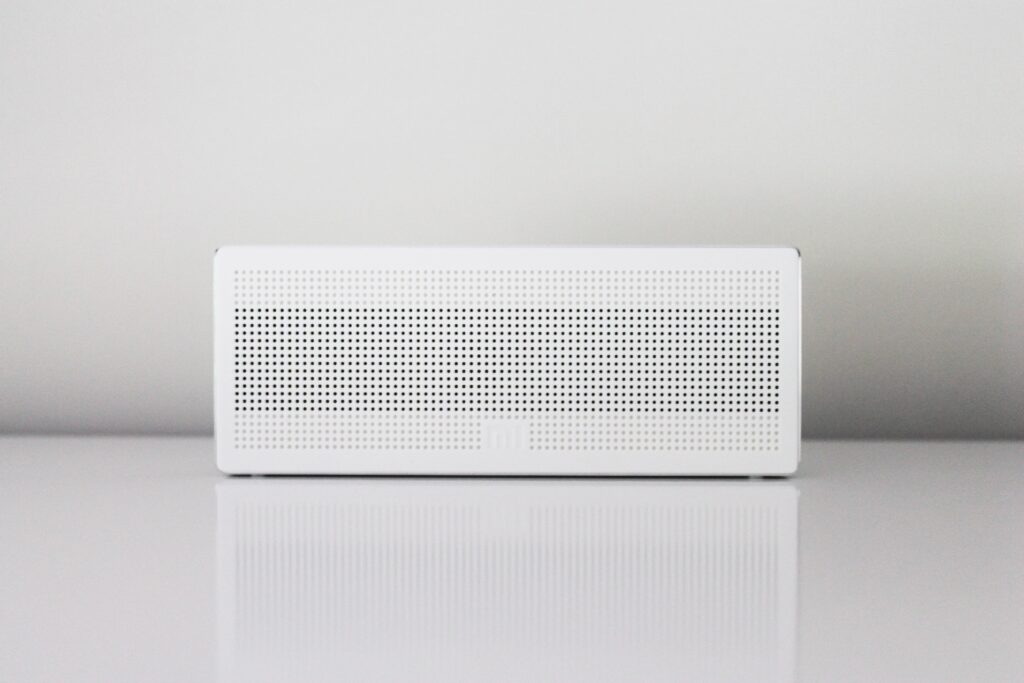
Air purifiers assist in removing airborne contaminants from the air in your house, such as dust and pollen. They are made to improve general indoor air quality and lessen indoor air pollution. In addition to efficiently removing dust, they can help lessen odors and ease dust allergy symptoms by trapping allergens in their filters.
Choosing an air purifier with a high-efficiency particulate air filter is crucial when buying. Most allergens and pollutants, such as dust mites and mold spores, are captured by HEPA air filters, which have been tested and shown to be effective in trapping 99% of airborne particles down to 0.3 millimeters in size. Thus, you may relax knowing that your air purifier will perform a good job!
Another factor to consider when buying an air purifier is its size. You should choose a unit that is the right size for the area you want it to clean. Smaller units are more suitable for bedrooms or workplaces because they don’t take up as much space, whilst larger ones may cover larger areas and remove more pollutants from the air.
⑧ Get the Right Duster
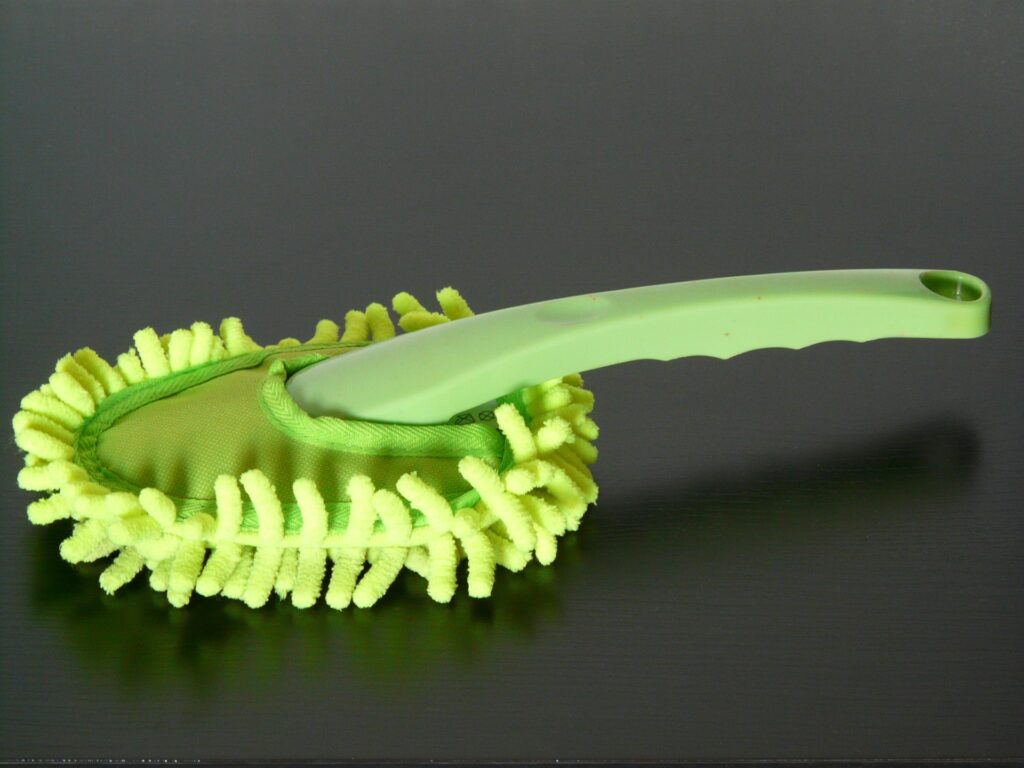
A good feather duster should be made of soft but durable material that can grab onto and lift away dirt, dust, and other particles without damaging any surface. It should also be easy to use and provide good coverage over furniture and hard-to-reach areas.
When looking for the perfect duster, consider the type of material it’s made from; some materials may be too abrasive, while others are designed specifically to pick up fine dust particles. You should also look into reusable options, as these can save you money in the long run by eliminating the need for disposable cloth or sponges.
Another thing worth considering is whether or not your duster will be comfortable to use and hold. Some models come with adjustable handles, to find one that fits comfortably in your hand. While comfort isn’t necessarily paramount about cleaning, having something comfortable makes it much easier to keep on top of regular dusting sessions.
One final tip when choosing a duster: check reviews from previous users before making a purchase, as this helps ensure that you end up with a quality product that will last for years.
⑨ No Carpeting
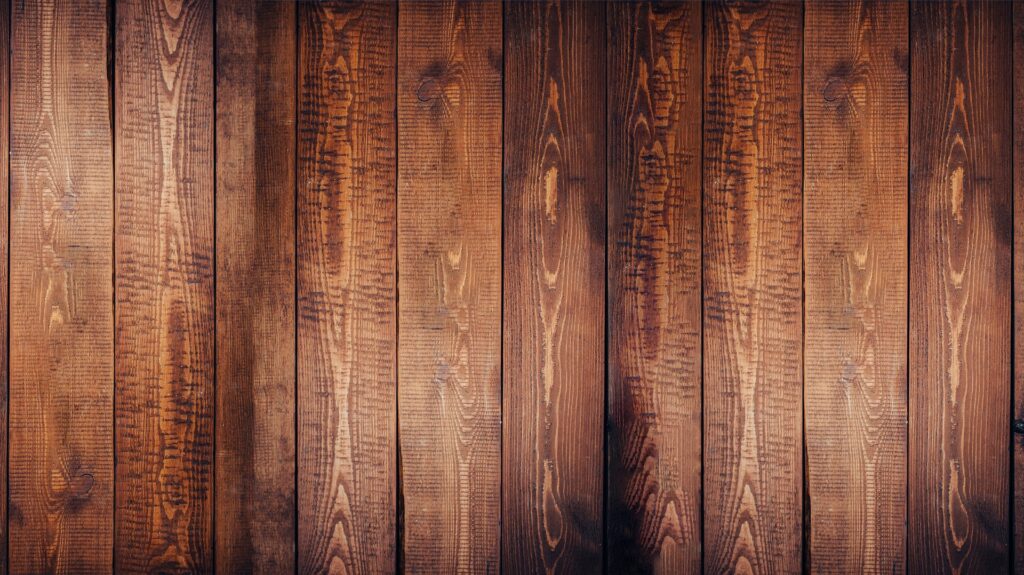
One of the best ways to remove all dust from your home is to eliminate carpeting. Although many people love the look and feel of carpets, they can be dust collectors. Carpets trap dust particles which can then recirculate throughout your house. Furthermore, deep-set carpets are difficult to clean thoroughly, meaning you may still have hidden dirt particles that get stirred up with every step you take.
If you want to keep your home free from dust, consider going without carpets. Instead, use flooring options like vinyl or hardwood that are easier to clean and maintain. You should also move furniture around regularly so that even the spots behind and underneath them don’t get too dusty.
⑩ Don’t Forget to Mop
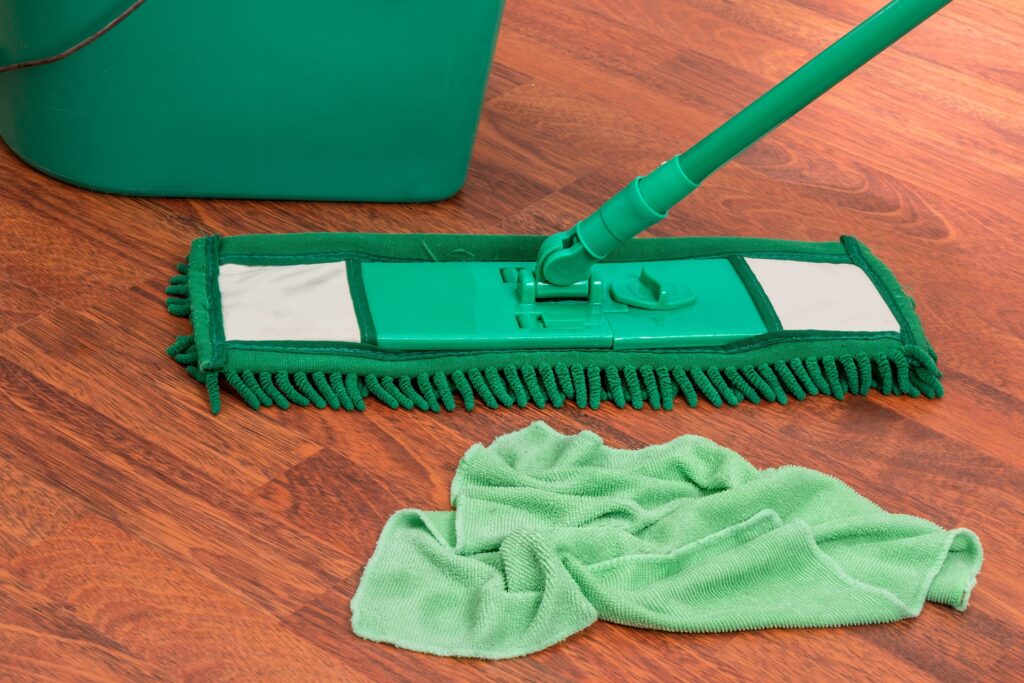
Mops are often an overlooked tool for cleaning your house. While vacuuming is great for picking up dirt and debris from carpets and rugs, a good old-fashioned mop can be invaluable for removing dust from hard surfaces like wooden floors and tile.
Most people think of mopping only when their floors get visibly dirty, but mopping is also a fantastic way to eliminate excess household dust. The moisture in the mop grabs hold of any accumulated tiny particles, leaving your home as good as new.
Remember that preparation is key when it comes time to break out your mop. Start by mopping the area with a broom or vacuum cleaner to remove as much loose debris as possible before adding water.
Then fill up your mop bucket with warm water and the cleaning solution you choose. Anything from plain water, vinegar, baking soda, or even store-bought cleaners. Dip the mop into the solution, then wring out any excess liquid, so it’s barely damp. Remember, too much water will leave too many streaks on hardwood floors after wiping them dry.
Finally, start mopping. Move in small circles starting at one corner and working towards other edges until you cover the whole floor. Change directions when necessary, so you don’t miss any spots! When you’re finished, replace your mop head with a fresh one (you don’t want to go over old ground again). Then, give everything another once-over before drying off any remaining liquid with a towel or rag.
Frequently Asked Questions
Q: Can cleaning services help with dusting?
Absolutely! Dusting is a pesky task many of us don’t have time for or dread doing. Cleaning services offer this service along with many other options: vacuuming, mopping, scrubbing surfaces, and more. They will dust even the hard-to-reach areas around furniture that can be difficult to maneuver around on your own. With professional dusting services, you know they will move everything safely while thoroughly cleaning and replacing it in the same spot. No need to worry about misplaced things! The best part is you don’t have to lift a finger; leave it up to the pros!
Q: How often should carpet cleaning be done?
When cleaning your carpets, the frequency of how often this should be done depending on foot traffic and usage. Generally speaking, carpets in higher traffic areas like hallways or living rooms should be deep cleaned every 12 to 18 months. On the other hand, lighter-use areas like bedrooms can usually wait a bit longer. If you have kids or pets in the house who play on the carpets often, though, then you might want to increase the timeline for regular cleanings. If you notice visibly soiled spots or strong odors emanating from your carpets, these could be signs that it’s time for some professional cleaning as well.
Q: Is dust removal important?
Dust removal is an extremely important process that should not be overlooked! Dust can damage and reduce the efficiency of appliances. It is a leading cause of respiratory problems like allergies and can contain hazardous particles that can harm people and the environment.
Q: How do I clean a ceiling fan to remove those dust bunnies?
The most important thing is to ensure the fan is off and unplugged before you start cleaning. With most fans, you only need a step ladder and some cleaning materials. Start by dusting off the blades using an extendable duster with microfiber cloths. This will ensure all those pesky dust bunnies are gone in one fell swoop! To really get into tight spaces, use an old toothbrush with a cleaning solution to remove grit and grime from more hard-to-reach spots. After wiping everything down, give the blades one final pass with a damp cloth. This will leave them looking shiny and new!
Final Words
Dedicating even just one hour during the week to dusting your home can make a difference in air quality. A few simple steps, such as regularly wiping surfaces with a damp cloth or feather duster, vacuuming or mopping up dirt, and using specialized vacuum attachments, can all make the process easier while helping keep your home clean and safe. Of course, this isn’t a one-time exercise. You will have to repeat these steps regularly to maintain the ideal level of cleanliness. Keep it up, and you’ll soon be on the path to having an impressively dust-free home!

